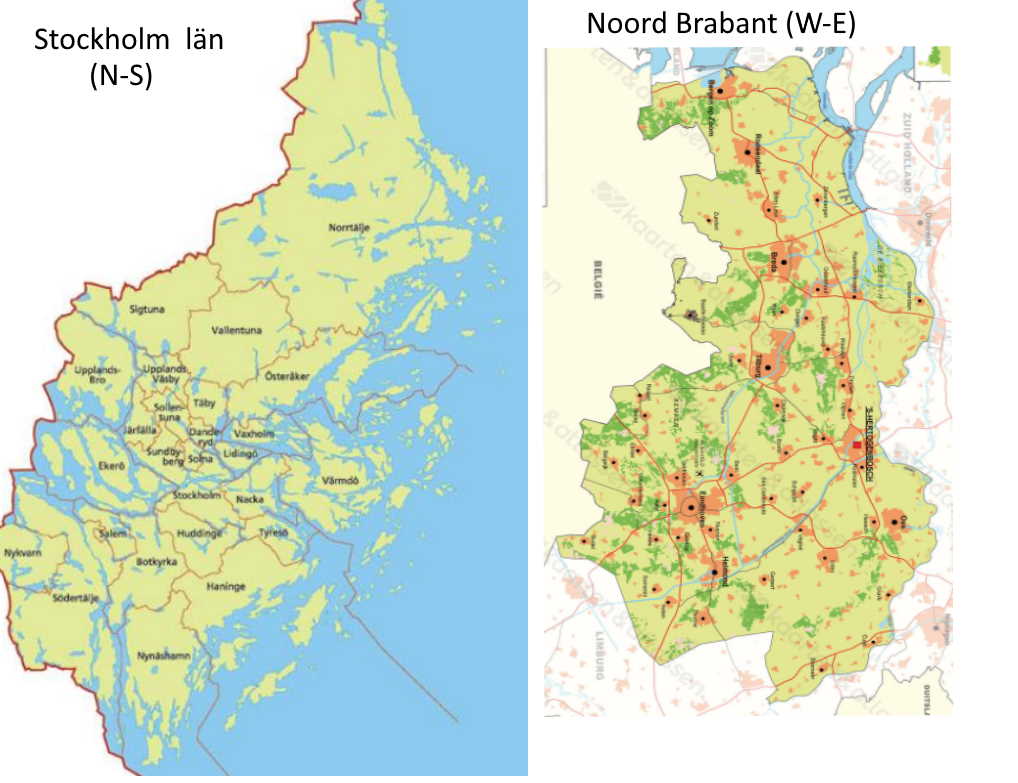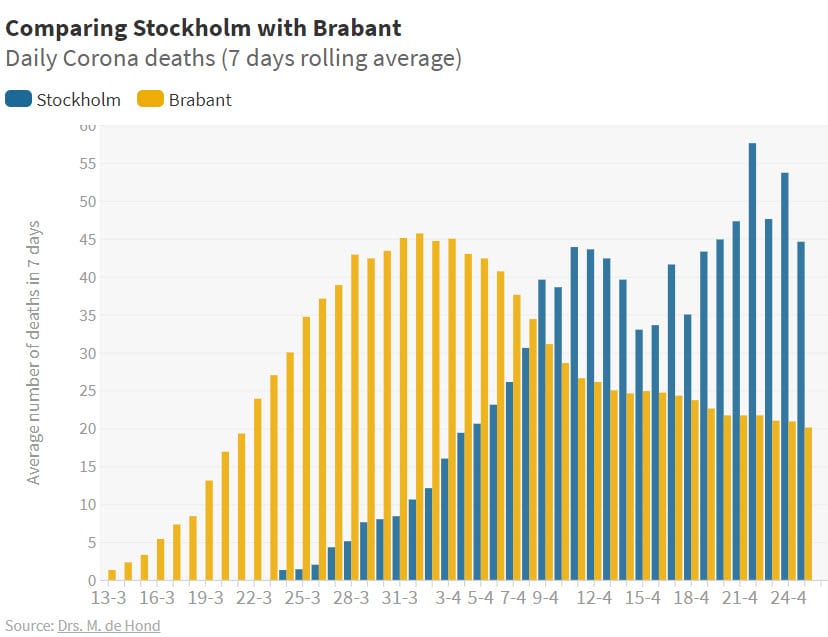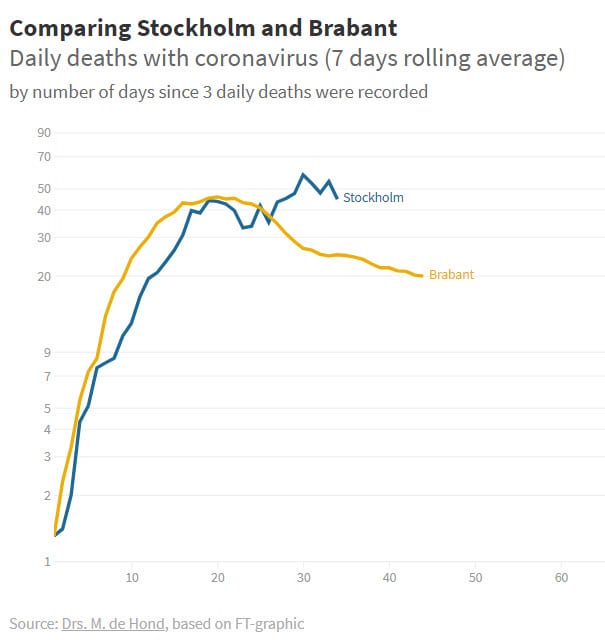Swedish Covid approach costs 30 more deaths per day For everyone in the world who is involved in the search for the right COVID-19 virus strategy, Sweden is super interesting. There they have not taken as hard measures as in many other countries (e.g. The Netherlands). When comparing the developments in the Netherlands and Sweden, […]
Lees volledig artikel: Swedish Covid approach costs 30 more deaths per day
Swedish Covid approach costs 30 more deaths per day
For everyone in the world who is involved in the search for the right COVID-19 virus strategy, Sweden is super interesting. There they have not taken as hard measures as in many other countries (e.g. The Netherlands).
When comparing the developments in the Netherlands and Sweden, it is important to realize that the population density in Sweden is much lower than in the Netherlands. So we are not going to focus our analysis on the whole of Sweden but on the province where Stockholm is located, because there we see an interesting comparison with Brabant.
The province in which Stockholm is located now has more than 1,000 COVID-19 deaths. That is 430 deaths per million inhabitants. Figures that resemble the RIVM figure of North Brabant, where the officially registered number is 600 (The province in which Stockholm is located is called Stockholm län).
If we compare Brabant with Stockholm län, there are considerable similarities in terms of number of inhabitants and surface area. (Brabant is 5,000 km2 and Stockholm län 6,500 km2. Brabant has over 2.5 million inhabitants, Stockholm almost 2.4 million).
This is the map of the two areas. To show that even the shapes resemble each other, I have tilted Brabant degrees.

Mortality
This graph shows that the development of mortality in Stockholm län started a little later and has grown a little slower. The peak in time came about two weeks later, but after a short fall it has risen again to a level of around 50.
The Dutch government announced the first measures on March 12. Preferably working from home and meetings with more than 100 people were banned. These measures were tightened on March 15. The entire event- and hospitality industry closed down and people were not allowed to walk outside in larger groups than 2 people. Schools were closed.
In Sweden, it was decided on March 11 that meetings with more than 500 people were forbidden. On March 17 schools were closed and people were advised to work from home. People over the age of 70 were advised to have as little contact with others as possible. On March 24, restaurants and bars were only allowed to serve people who sat at tables. Restaurants had to increase the distance between tables. On March 27 meetings with more than 50 people were forbidden.
In absolute terms, the relative number of deaths in Stockholm län does not seem to be far from that of Brabant, but the decline that started in Brabant is not yet visible in Stockholm län, although it did look like it at first.
This can also be shown in the display FT.com uses on its website to make international comparisons and which I have described here.
This graph also gives the same picture.
The pattern of the first 25 days is quite similar. But the question is whether Stockholm will now start a downward movement or stabilize at the level of around 50 deaths per day,
Now there are two possible problems to compare the series of the two countries.
- Is the number of registered deaths the real number?
- How does the population structure differ and what consequences can that have?
Ad 1. The real number of additional deaths due to COVID-19
The Economist keeps a record in 11 countries of the extent to which the excess mortality in their population register differs from the officially declared COVID-19 deaths. Both the Netherlands and Sweden are recorded.
1.4 times higher
This table shows that mortality in the Netherlands is more than twice as high as the figures given by the Dutch RIVM. In Sweden these figures are 1.4 times higher.
So if this finding is applied to the table, Brabant would have stood at 100 per day in real life and now at around 50. Stockholm’s maximum would be around 70 per day.
ad 2. The difference in age structure
According to the RIVM, 76% of the COVID-19 casualties in the Netherlands are 75 years of age or older.17% are between 65 and 74 years of age. The figures in Sweden are almost the same.
In Brabant, the proportion of residents aged over 75 is 9% and between 65 and 74, 11%. In Stockholm this is somewhat less, 7% and 9% respectively.
The smaller number of elderly people in Stockholm will therefore have a ‘positive’ effect on the number of deaths. Given the difference in age structure, this would mean that Brabant could have a third more victims than Stockholm.
Correction and correction
And that means that the correction we have just applied on the basis of the excess mortality in the population register, is now being corrected again. The maximum number of deaths per day is approximately the same in both provinces.
On the basis of the research I have done in the Netherlands, I think that the measure that still works unfavorably in Sweden is that meetings of less than 50 people have not been banned. This could mean that certain super spread events could still occur there, as happened in the Netherlands before the intelligent lock down was introduced.
The next two weeks will show whether the number of victims in Stockholm will fall or remain more or less stable or increase.
Suppose the number of deaths per day in Stockholm län remains around that 50 per day, while Brabant now drops to around 20 deaths per day, then that difference of 30 deaths per day is the price Stockholm län pays by not going into a kind of lock down as was the case in the Netherlands. That means per 100,000 inhabitants about 1.5 more deaths per day.
You have just read: Swedish Covid approach costs 30 more deaths per day.










